#labyrinthodont
Text
Crystal Palace Field Trip Part 1: Walking With Victorian Monsters

The Crystal Palace Dinosaurs take their name from the original Crystal Palace, a glass-paned exhibition building originally constructed for a World's Fair in Hyde Park in 1851.
In 1854 the structure was relocated 14km (~9 miles) south to the newly-created Crystal Palace Park, and a collection of over 30 life-sized statues of prehistoric animals were commissioned to accompany the reopening – creating a sort of Victorian dinosaur theme park – sculpted by Benjamin Waterhouse Hawkins with consultation from paleontologist Sir Richard Owen.
The Palace building itself burned down completely in 1936, and today only the ruins of its terraces remain in the northeast of the park grounds.

The Crystal Palace building then and now
Left image circa 1854 (public domain)
Right image circa 2011 by Mark Ahsmann (CC BY-SA 3.0)
Six sphinx statues based on the Great Sphinx of Tanis also survive up among the Palace ruins, flanking some of the terrace staircases. They fell into serious disrepair during the latter half of the 20th century, but in 2017 they all finally got some much-needed preservation work, repairing them and restoring their original Victorian red paint jobs.

———
…But let's get to what we're really here for. Dinosaurs! (…And assorted other prehistoric beasties!)
The "Dinosaur Court" down in the south end of the park still remains to this day, displayed across several islands in a man-made lake. Over the decades they've been through multiple cycles of neglect and renovation, and are currently cared for by the London Borough of Bromley (Crystal Palace Park Trust are due to take over custodial duties in September 2023), with promotion and fundraising assistance from organizations like Historic England and the Friends of the Crystal Palace Dinosaurs charity.
Just about 170 years old now, the Crystal Palace Dinosaurs represent fifteen different types of fossil creatures known to 1850s Victorian science, with only three actual dinosaur species featured. Although often derided for being outdated and very inaccurate by modern standards, they were actually incredibly good efforts at the time, especially taking into account that the field of paleontology was still in its very early days.
They also just have a lot of charm, with toothy grins and surprisingly dynamic poses.
Unfortunately on the day I visited in early August 2023 most of the statues were heavily obscured by plant growth, both on their islands and on the sides of the paths they can usually be viewed from. Since I'd seen images from about a month ago showing things being less overgrown, this was probably just some unlucky timing on my part coinciding with some explosive summer foliage growth.

The first island on the trail features a few Permian and Triassic animals which were only known from fragmentary remains in the 1850s. These "labyrinthodonts" were recognized as having similarities to both amphibians and reptiles, and so were depicted with boxy toothy jaws, warty skin, stumpy tails, and long frog-like back legs.

Today we'd call these particular animals temnospondyl amphibians, specifically Mastodonsaurus, and we know they were actually shaped more like giant salamanders with longer flatter crocodilian-like jaws, smaller legs, and long paddle-like tails.

———

Somewhere in the foliage beyond this specific "labyrinthodont" there was also supposed to be a pair of dicynodonts, but I couldn't see much of them at all and didn't manage to get a remotely visible photograph.

Crystal Palace Dicynodon when much less overgrown
Left photo by London looks (CC BY 2.0)
Right photo by Loz Pycock (CC BY SA 2.0)
These Dicynodon are depicted as looking like sabre-toothed turtles complete with shells. That was fairly speculative even for the time, but considering only their weird turtle-beaked-and-walrus-tusked skulls were known it was probably the best guess Hawkins and Owen had. Today we know these animals were actually synapsids related to modern mammals, but Victorian understanding considered them to be a type of reptile.
Modern reconstructions of dicynodonts have a slightly different face shape, along with squat pig-like bodies and semi-sprawling limbs. They may have had fur, but currently the only known actual skin impressions from the genus Lystrosaurus show leathery bumpy hairless skin.

———
Next time: the Jurassic and Cretaceous sculptures!
#field trip!#crystal palace dinosaurs#retrosaurs#i love them your honor#crystal palace park#crystal palace#labyrinthodont#temnospondyl#mastodonsaurus#dicynodont#dicynodon#synapsid#paleontology#vintage paleoart#art
374 notes
·
View notes
Text
FINALLY got these done (yeah I know Bridget & Testament don't look the best)

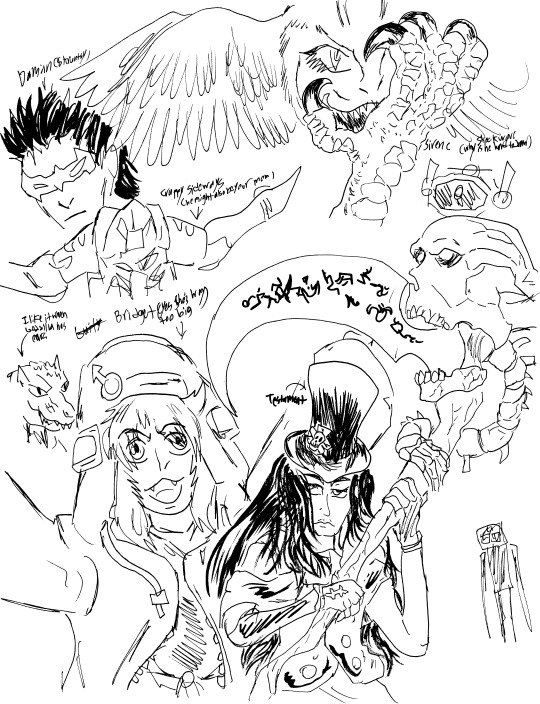


#fan art#fanart#artwork#art#bridget#testament#paleoart#paleo art#diplodocus#rugops#balaur#dunkleosteus#labyrinthodont#thrinaxodon#dinosaurs#sirene#damian wayne#my art#my artwork
3 notes
·
View notes
Note
I have a prompt for you: labyrinth of the labyrinthodont.
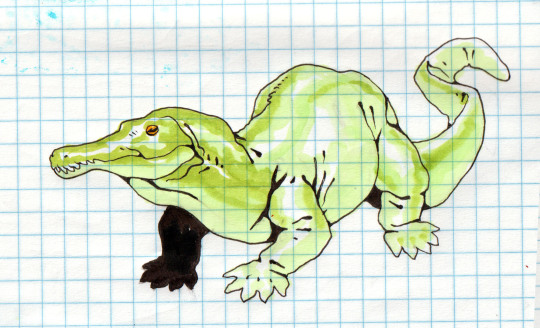
Some kind of temnospondylic crocodile-analogue
151 notes
·
View notes
Note
I honestly had a theory that Andrias was a Labyrinthodont, a group of amphibians with similar niches to crocodiles today. I'm aware he is based on a giant salamander but given his size and the fact he is so powerful I think it would have been cool if he was part of something older, more than a mere newt but the remaining survivor of a more ancient time.
I mean, who's to say that Andrias doesn't come from a line with them and is why the Leviathan family are so large compared to other newts
9 notes
·
View notes
Text

Hello there ! Long time since I’ve post something here !
Here’s a little doodle page I did a few weeks ago featuring Mily and her boyfriend Yannou. She took him to a new dinosaur park called Jurassic Universe.
In my AU, after the events of Dominion, it was just too hard for the world to coexist with dinosaurs so Mily and Orion had an idea about bringing them in an empty world they ended up calling « Jurrasic Universe ».
Since I’m playing Jurassic world the game (it’s awesome btw) I imagined that the dinosaurs I have in the game were born in Jurassic Universe : there’s Ripper (the indoraptor in Fallen kingdom) and his sister Rona (because in the movie Ripper was suppose to have a white sibling so I imagined it’d be a female I called Rona). Then there are other dinosaurs OCs that I imagined from the game : Laby the labyrinthodont, Quetza the baby Quetzalcoatlus, Natsu the Natsuceratops and a little baby hybrid Hobbes the labyrinthosaurus.
Note : Ripper belongs to Universal studio.
Mily and Yannou belong to me.
If you guys are curious about why Ripper and Rona are here, why are there new hybrids and just how Jurrasic Universe came to be, don’t hesitate to ask your questions in the comments of the Q&A.
Bye 😊.
Coucou ! Ça faisait un moment depuis que j’ai publié !
Voici une petite page de griffonnage datant de quelques semaines mettant en jeu Mily et son petit copain Yannou. Elle l’a emmené dans un nouveau parc à dinosaure appelé l’Univers Jurassique.
Dans mon Univers alternatif, après les événements Du Monde d’Après, le monde n’arrivait à coexister avec les dinosaures alors Mily et Orion eurent une idée : les emmener dans un monde vide qu’ils ont fini par appeler « Univers Jurassique ».
Vu que je joue à Jurassique world le jeu (qui est génial d’ailleurs) j’ai imaginé que les dinosaures que j’ai dans le jeu sont nés à l’Univers Jurassique : il y a Ripper (l’indoraptor dans Fallen kingdom) et sa sœur Rona (par ce que dans le film Ripper devait avoir un frère blanc alors j’ai imaginé que ce serait une femelle appelée Rona). Puis il y a d’autres dinosaures que j’ai imaginé du jeu : Laby le labyrinthodonte, Quetza le bébé Quetzalcoatlus, Natsu le Natsuceratops et un petit bébé hybride Hobbes le labyrinthosaure.
Note : Ripper appartient a Universal studio.
Mily et Yannou sont mes personnages.
Si vous êtes curieux au sujet de la présence de Ripper et Rona, la présence de nouveaux hybrides et comment l’Univers Jurassic a vu le jour, n’hésitez pas à poser vos questions dans la FAQ.
Au revoir 😊.
0 notes
Text
Mastodonsaurus

By Tas Dixon
Etymology: Nipple-toothed reptile
First Described By: Jaeger, 1828
Classification: Biota, Archaea, Proteoarchaeota, Asgardarchaeota, Eukaryota, Neokaryota, Scotokaryota Opimoda, Podiata, Amorphea, Obazoa, Opisthokonta, Holozoa, Filozoa, Choanozoa, Animalia, Eumetazoa, Parahoxozoa, Bilateria, Nephrozoa, Deuterostomia, Chordata, Olfactores, Vertebrata, Craniata, Gnathostomata, Eugnathostomata, Osteichthyes, Sarcopterygii, Rhipidistia, Tetrapodomorpha, Eotetrapodiformes, Elpistostegalia, Stegocephalia, Tetrapoda, Temnospondyli, Limnarchia, Stereospondylomorpha, Stereospondyli, Capitosauria, Mastodonsauridae
Referred Species: M. jaegeri, M. cappalensis, M. giganteus, M. torvus
Status: Extinct
Time and Place: 247 to 237 million years ago, from the Anisian to the Ladinian of the Middle Triassic
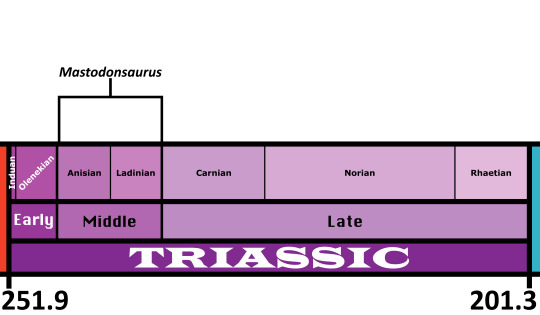
Mastodonsaurus is known mostly from Germany and Russia.

Physical Description: Mastodonsaurus was a very large temnospondyl, growing up to 6 meters (20 feet) long. It’s one of the largest “amphibians” (if you accept the term to mean non-amniote tetrapods) known from actually decent remains. This thing’s downright badass. Its head was large, wide and flattened, with the eyes positioned at the top about ⅔ of the way back. The head was roughly-textured, being covered in rugosities that suggest a tight covering of skin. The upper and lower jaws were filled with spikelike teeth, of which there were two rows in the upper jaw. Each tooth has a complex labyrinthine structure in cross section, leading to the colloquialism “labyrinthodont” for big temnospondyls like this. Two teeth in the front of the lower jaw had developed into large tusks, which were so large that there are holes on the top of the jaw for the tusks to go through when the mouth was closed. I repeat: IT HAD HOLES IN ITS SKULL BECAUSE ITS TEETH WERE SO BIG. That’s downright gnarly. The upper jaw also had enlarged fanglike teeth on the palate, but they weren’t that huge. Postcranially Mastodonsaurus was similar to other temnospondyls, with short, sprawling limbs and a powerful tail.
Diet: Mastodonsaurus’s diet likely consisted of any living or until-recently-living animal that happened to be in the water (including if it was pulled in).
Behavior: Mastodonsaurus likely lived similarly to modern crocodiles, lurking in waterways waiting for prey. In the water it may have done short chases after prey such as fish and other temnospondyls, but it probably ambushed tetrapod prey. Its limbs were quite small relative to the rest of its body, indicating that it likely spent most of, or even almost all of, its time in the water. It may have been able to attack animals on the banks of waterways, but that’s probably the most it did on a regular basis: grabbing prey on the shore of the water and dragging it back in to be eaten.
Ecosystem: Mastodonsaurus lived in environments with lots of freshwater. Some Mastodonsaurus-preserving environments also bear marine fossils, suggesting it may have also lived in coastal deltas or estuaries. M. jaegeri, M. cappalensis and M. giganteus lived in what is now west-central Europe. This area was evidently very wet, as evidenced by the variety of aquatic animals discovered there. These include fellow temnospondyl Gerrothorax, the nothosaurs Nothosaurus and Simosaurus, the early turtle Pappochelys, Tanystropheus, sharks, mollusks, and our old friends Ceratodus and Saurichthys. Some terrestrial animals also lived in this area, like cynodonts and the pseudosuchians Batrachotomus and Ctenosauriscus. Meanwhile, M. torvus lived in what is now Russia, alongside fellow temnospondyls Plagioscutum and Plagiorotus, the prolacertid Malutinisuchus, the rauisuchid Energosuchus, the erythrosuchid Chalishevia, and Elephantosaurus, a dicynodont with a horrible name.
Other: I try not to be an awesomebro, but this thing was pretty cool.
~ By Henry Thomas
Sources under the cut
Moser, M., Schoch, R. 2007. Revision of the type material and nomenclature of Mastodonsaurus giganteus (Jaeger) (Temnospondyli) from the Middle Triassic of Germany. Palaeontology 50(5): 1245-1266.
Owen, R. 1842. On the Teeth of Species of the Genus Labyrinthodon (Mastodonsaurus of Jaeger), common to the German Keuper formation and the Lower Sandstone of Warwick and Leamington. Transactions of the Geological Society of London 2(5). 503-513.
Schoch, R.R. 1999. Comparative osteology of Mastodonsaurus giganteus (JAEGER, 1828) from the Middle Triassic (Lettenkeuper: Longobardian) of Germany (Baden-Wurttemberg, Bayern, Thuringen). Stuttgarter Beitrage zur Naturkunde B 278: 1-175.
#mastodonsaurus#temnospondyl#labyrinthodont#triassic#triassic madness#triassic march madness#prehistoric life#paleontology
293 notes
·
View notes
Photo
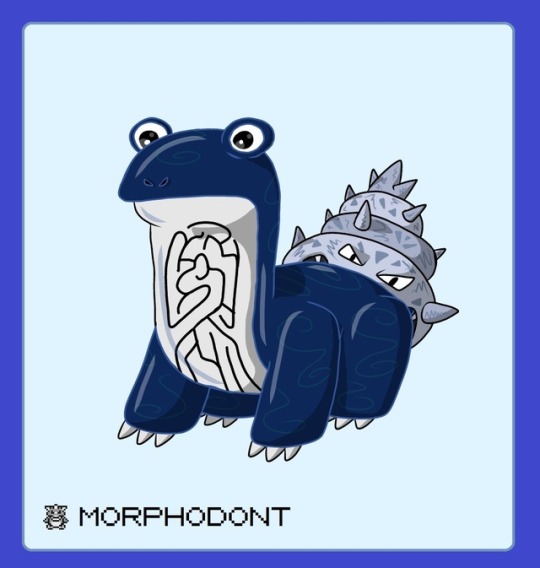
Morphodont
After the Permian extinction, Shellder lost the ability to evolve into Coiyler on its own, but it was able to take on a similar form through symbiosis with another pokemon. Slowpoke wouldn’t exist for another 200 million years, so Shellder bit the tails of Protopoli instead, causing it to evolve.
The maze pattern on this pokemon’s belly is different on every individual specimen.
Water/Psychic
Triassic - Cretaceous
Tiktail > Protopoli > Morphodont
#pokemon#fakemon#paleomon#fossil pokemon#prehistoric pokemon#water#psychic#shellder#slowbro#slowpoke#poliwag#poliwhirl#poliwrath#politoed#labyrinthodont#amphibian#triassic#cretaceous#symbiosis
16 notes
·
View notes
Photo

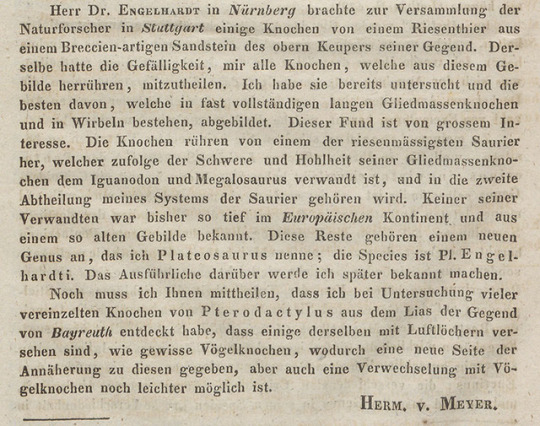
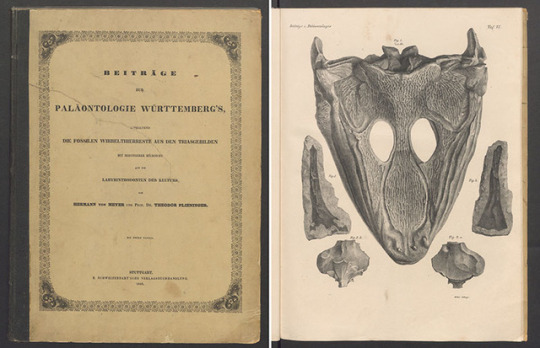


Hermann von Meyer – Scientist of the Day
Hermann von Meyer, a German paleontologist, was born Sep. 3, 1801.
read more...
#Hermann von Meyer#Archaeopteryx#Plateosaurus#Mastodonsaurus#labyrinthodonts#histsci#histSTM#19th century#history of science#Ashworth#Scientist of the Day
10 notes
·
View notes
Note
Does the lepospondyl + cotylosaur clade represent a single loss of labyrinthodont teeth?
Perhaps... if that’s a real clade. There’s a fair amount of reshuffling near the base of Amniota these days.
1 note
·
View note
Text
Transitional Fossil Time!
Tulerpeton
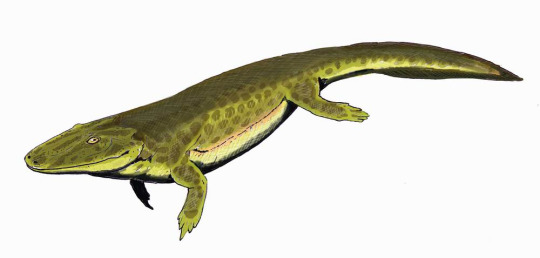
A large animal with paddle-like six-toed feet. Despite its many aquatic adaptations (nostrils at the top of the muzle, paddled feet, paddle-like tail, etc) it did not have gills in adulthood, and is thus the earliest labyrinthodont (amphibian) known to depend entirely on breathing with its lungs.
3 notes
·
View notes
Text
I’m not gonna do a biological analysis on legendary Godzilla because honestly there’s not much that I can say that @mayajadeart hasn’t already said.
However I am going to say a few things about him.
1. I’ve seen people theorize that he’s descended from many things. From pseudosuchians to labyrinthodonts, but honestly I think he’s probably descended from some kind of early reptilimorph.
2. He’s a radiotrophic organism much like radiotrophic fungus and honestly there’s no shortage of melanin on his gray body. He’s gray all over so it makes sense.
3. His atomic breath is a beam of Cherenkov radiation and he can emit the same glow from his face and dorsal scutes as an intimidation display.
4. Maybe the reason the tail is shorter in the 2019 version in comparison to the 2014 version is because it got cut off and it didn’t grow back quite as long much like how some lizards regrow tails.
5. My silly explanation for his spinier appearance in 2019 is that it’s nearing mating for him so they’re big and elaborate, and then afterwards they fall off like antlers and grow back. In 2014 he was probably between mating seasons so they weren’t as fantastic looking.
#godzilla#biological analysis#kaiju biology#speculative biology#speculative evolution#legendary godzilla
18 notes
·
View notes
Photo
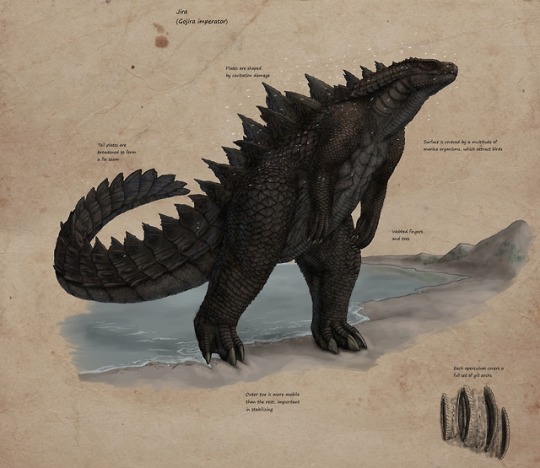
In 1954, the Cold War threatened to escalate when nautical vessels of both sides were found destroyed beyond recognition or vanishing altogether. However, the reports of the few survivors of the attacks didn't match up with the initial assumption that these were undercover attacks, as all of them had described the vessels being attacked by some sort of gigantic creature, and indeed, a section tasked specifically to deal with those incidents had affirmed the survivors' reports: there was a vaguely crocodylian creature with a length of almost 300 metres roaming the oceans almost undetected.
Searching through historical accounts, it became clear that this creature dubbed as „Gojira“ by a Japanese soldier, who had described it as „a sort of whale with gorilla arms“, had been known throughout human history with a number of accounts mentioning large sea monsters. The creature finally became known to the general public in 2014 together with the Mutos when it attacked the male in Hawaii, then chased it down to San Francisco, killing both Mutos in a fight that left half of the city in shambles.
Such a life in secrecy despite the enormous size was only possible for the creature as Jiras have re-evolved gills and have a preference for the cold, lightless depths of the oceans' abyssal zone, where the low temperatures keep them from overheating easily. They orient themselves with a mixture of echolocation and electrolocation, using their massive electrical organs to maintain a field similar to electric fish. Aside from oxygen, the gills are also used to filter uranium from the sea water, which is usually enough to spend longer times submerged, but if a need for more radioactive material arises, Jiras would leave the sea and seek out areas with felsic, highly fractionated rocks where radioactive elements become enriched to eat the rocks or spend time in the proximity of river mouths that drain from such areas. Non-radioactive sustenance is taken up in the form of fish swarms that are filtered out of the water with gill reuses or whale carcasses that sink into the abyssal zone.
Possessing both gills and lungs, Jiras had to develop a number of adaptations to be able to switch between the systems. For once, they possess a bypass in their heart septum similar to crocodiles that allows them to reduce the bloodflow to their lungs, instead maintaining a fish-like circulatory system that pumps blood directly from the gills to the body without an extra system for the respiratory organs. Another feature is that the lungs and adjacent airsacs can be completely flooded with water and have a secondary function as hydrostatic organs. How exactly the gills were re-evolved is unknown; it is unusual that underneath each operculum there are up to five gill arches, implying that it wasn't just simple reactivation, but also multiplication of the organs, most likely to maintain a proper oxyggen supply for such a colossal creature.
An even stranger feature than the gills is the ability to generate plasma and exhale it as a weapon, an ability that was only recently discovered. The exact mechanism isn't known, it seems the large electrical organs that run along the back are able to generate a magnetic field powerful enough to turn air molecules into ions, as well as to manipulate the charged particles. A system of air-filled channels runs through the electrical organs, which partially extends into the dorsal plates in triangular loops, either to prevent overheating or to be used as a sort of display, as the plasma is able to shine through the channels.
The exact relation of Jiras to other known animals is not exactly known; a speculative skeletal drawing from the 18. century depicts it with mammalian features, older accounts described it as a fish and modern scientists put it as either a dinosaur or a crocodylian. The find of the Philippines skeleton allowed a closer examination, which revealed it to be an anapsid. There are also features regarding the teeth and vertebrae that are more labyrinthodont-like, leading to debate whether Jiras are anapsids with labyrinthodont features added by the chimera virus or the other way around. What is clear is that the species dates back to at least the Permian, as has been found out by re-examining ichnofossils that have been previously thought to be anorganic geological features.
Still, there is very little known about the species, as it seems to be functionally extinct with one elusive individual remaining. However, the oceans are vast and one cannot tell what else might be living down there...
And the last one for now. Calling the species „Jiras“ is something I took from the leaked script; since the individual names for the Mutos were taken from there, why not takin Godzilla's species name from there, too? Also, I take everything back I wrote about the mother longlegs and the mire squid being nightmares to draw. This fucker and his scales were the longest bullshit submission I have done so far, the fact I was displeased with the appearance of the limb scales most of the time and redrew them two or three times didn't help.
Changelog:
-Made him even fatter, for a more streamlined shape
-Added a tail fin and extended/added webs between fingers and toes
-Changed around the shape of some scales, making them based more on turtles than crocodiles
121 notes
·
View notes
Text
Huh, has anyone talked of these guys?
and on one far continent I saw the crude villages of the black-snouted, winged creatures who would evolve as a dominant stock after the Great Race had sent its foremost minds into the future to escape the creeping horror.
Of the animals I saw, I could write volumes. All were wild; for the Great Race’s mechanised culture had long since done away with domestic beasts, while food was wholly vegetable or synthetic. Clumsy reptiles of great bulk floundered in steaming morasses, fluttered in the heavy air, or spouted in the seas and lakes; and among these I fancied I could vaguely recognise lesser, archaic prototypes of many forms—dinosaurs, pterodactyls, ichthyosaurs, labyrinthodonts, rhamphorhynci, plesiosaurs, and the like—made familiar through palaeontology. Of birds or mammals there were none that I could discern.
Huh. Pterosaurs species that had a brief civilization after the Great Race of Yith escaped the polyps?
The period of my dreams, apparently, was one somewhat less than 150,000,000 years ago, when the Palaeozoic age was giving place to the Mesozoic.
Leila Hann Let’s Read : A little earlier than I expected. Either Lovecraft is positing that we just haven’t found the earliest fossil records of some of these clades, or he was faithfully going off of what was then accepted paleontology.
0 notes
Photo
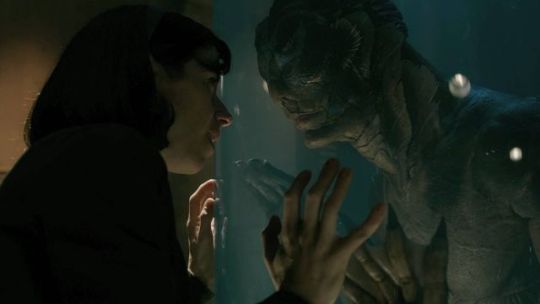
As promised back in July when the first trailer for THE SHAPE OF WATER (Dir. Guillermo del Toro) dropped my hope for some time now has been to put together a series of posts dealing with this film leading up to its release which I have now come to understand will be Dec. 8th in NYC/LA and most likely Dec. 15th everywhere else. I wanted to do this because as I asserted in my original post, SHAPE is clearly a homage to Universal Studio’s classic monster movie THE CREATURE FROM THE BLACK LAGOON (1954, Dir. Jack Arnold) which, though perhaps not widely recognized as such, is a work of paleo-fiction as its entire premise revolves around a paleontological expedition to the Amazon to look for fossils after a single skeletal humanoid forelimb dating to the Devonian period is found. Of course once our explorers reach the fabled Black Lagoon they quickly discover more than just fossils.
Since that time writer/director Guillermo del Toro has openly confirmed that CREATURE was, in fact, the principal inspiration for SHAPE based largely on his rather unorthodox reaction to viewing the film when he was six…
LAT: Going back to the beginning, what was the initial germ of this movie?
GDT: I’ve had this movie in my head since I was 6, not as a story but as an idea. When I saw the creature swimming under Julie Adams [in 1954’s “Creature From the Black Lagoon”], I thought three things: I thought, “Hubba-hubba.” I thought, “This is the most poetic thing I’ll ever see.” I was overwhelmed by the beauty. And the third thing I thought is, “I hope they end up together.”
LAT: I kind of doubt that’s what most 6-year-olds were thinking.
GDT: No, I’m a weird one. [Source]
Now my original intention was to put together a kind of historical overview of the literary and cinematic elements which both connect Universal’s CREATURE to del Toro’s SHAPE as well as those which predate CREATURE. Alas once I actually began researching the matter I quickly realized that I had resigned myself to an abyss of unfathomable depth which I have neither the time nor resources to adequately explore at this current phase. This does not mean that I am abandoning my original plan however. Instead what will follow from this point forth will be a highly abridged, limited and non-comprehensive overview of this subject. In other words, I’m going to be leaving a lot of stuff out and I’m going to be doing so intentionally. Nevertheless I feel strongly that what I do have to present will still be of interest to followers of this blog. We’re going to be churning the depths, plunging back in time to locate the very origins of the creature at the heart of THE SHAPE OF WATER.
TAKING SHAPE: PALEONTOLOGICAL ORIGINS
When thinking about where to begin with a series dealing with the history of amphibious humanoids the first thought which crossed my mind was that we would need to start with the mermen and mermaids of myth and legend. This would take us back to the very beginnings of human civilization as depictions of mermen can be found carved on the stone walls of the Assyrian city of Dur-Sharrukin which dates back as far as 706 BCE. However upon further consideration it occurred to me that such a trip back to hoary antiquity seemed entirely unnecessary. Why? Because the amphibious humanoids featured in both del Toro’s THE SHAPE OF WATER and Universal’s THE CREATURE FROM THE BLACK LAGOON are not mermen. They’re Gill-men.
Now before anyone says anything I am well aware that everyone from Guillermo del Toro on down has been calling the creature in SHAPE a merman. That’s fine. I’m not about to fault anyone for the use of familiar nomenclature, especially when trying to sale/explain a concept as admittedly offbeat as the one which comprises the narrative core of SHAPE. That said I am going to make a distinction here, because while mermen/mermaids are certainly kith and kin to gill-men/gill-women they are nevertheless not the same. This is not merely an issue of semantics but rather one of taxonomy. There are a number of fundamental differences between mermen and gill-men and the first, and perhaps most important, is present right in their very names.
Gill-men have gills. Mermen don’t.
Naturally a lack of gills on your average fairy-tale merman/mermaid should raise the serious question of how exactly it is possible for such a creature to live under the water. But before one starts to concoct wild and elaborate theories about the respirational capabilities of Disney’s Ariel, perhaps we should acknowledge the most simple and straightforward answer to such a query: magic. Yes, magic. And what this tells us is that mermen and mermaids are the providence of fantasy. Their very existence, from their lack of gills to the fact that they are literally half-a-person and half-a-fish stuck together in the middle, is the product of a complete and unadulterated imagination unconcerned with questions of biological probability. To question how it is that a merman/mermaid is able to breath underwater is to utterly miss the point of such a creature.
So then what of our gill-man? The presence of gills, not to mention the fact that gill-men tend to be imagined not as fish-human chimeras but rather as more fully integrated creatures with scales and fins covering their whole body, tells us that they are not to be understood as a product of imaginative magical whimsy. The gill-man is a creature of science-fiction, not fantasy. The gills are there to help us suspend our disbelief and concede that – just maybe – such a being is possible and could exist in our world alongside us.
This also means that the gill-man is of a much more recent vintage then the merman, being the product of a modern scientifically minded age. More specifically I would argue that the notion of a gill-man could not exist prior to the advent of the science of paleontology during the latter half of the 18th-Century and the beginning of the 19th-Century in Western Europe.
In 1798, French zoologist George Cuvier – remembered today as the “Father of Paleontology” – formulates what will become known as the Principle of the Correlation of Parts, which states that all organs in an animal’s body are deeply interdependent and never mismatched. This is an important argument for the future of paleontology as it explains why it is possible for a paleontologist to extrapolate what an animal may have looked like in life even while working form only a handful of fragmented bones. The Principle of the Correlation of Parts tells us that certain types of bones will only ever belong to certain animals, thereby negating the possibility of creatures with mismatched parts; such as the body of a lion and the head and wings of an eagle or the head of a horse and the body of a fish. Because of this Cuvier likewise declares that mythological chimeras such as mermen/mermaids are scientifically untenable in principal.
However as science historian Brian Regal has argued, even while men like Cuvier were busy banishing mythological monsters back to the mists from which they came, the rise of Darwinian evolutionary theory helped to give birth to brand new ones. Fantasy fusions of man and beast like the merman might not exist, but scientists like Charles Lyell said there were ‘Missing Links’ out there, creatures which represented the transitional stage between man and animal. Today such transitional fossils are generally understood to be of a human-simian nature but this was not always the case.
The year 1844 saw the publication of what might be described as the first ‘best-selling’ book for a popular audience on the subject of paleontology: Vestiges of the Natural History of Creation (1st Ed. Oct. ‘44) by Robert Chambers. Chambers was not a paleontologist – or any kind of scientist – but rather a journalist with a strong interest in science, specifically geology and evolutionary theory. This is not intended as a slight against Chambers. Science has always needed popularizers who are capable of making complex ideas accessible to the public and paleontology has been fortunate enough to have a quite a few such as John Noble Wilford [The Riddle of the Dinosaur, 1985] and Brian Switek [My Beloved Brontosaurus, 2013]. Chambers, in this regard, was the first great popularizer of paleontology. However Chambers didn’t always get everything right.
Case in point: Just a decade prior to the publication of Vestiges, paleontologists had discovered a set of fossilized track ways in Lower Triassic sandstone in Thuringia, Germany. These tracks bared an uncanny semblance to human handprints or possibly primate footprints and the initially thinking among many scientists was that they were just that. As a result the track maker was dubbed Chirotherium (“hand-beast”) and presumed to possibly be amongst our oldest ancestors. Then two years before the publication of Vestiges, British paleontologist Richard Owen – the man who coined the word “Dinosaur” – suggested that the tracks were made not by a primitive primate – which by all accounts had not yet evolved by the time of the Triassic – but rather by a labyrinthodont amphibian.[1] As a result of what can only be assumed to be a serve case of misunderstanding Chambers, apparently thinking about the Chirotherium tracks and the two conflicting interpretations of them, put forth the, in hindsight, admittedly bizarre suggestion in Vestiges that mankind had evolved from an extinct species of giant amphibian.
This then is the paleontological origin of our modern-day gill-man. A missing link between the sea and land. Between fish and mankind. And while such a creature never really existed the underlying assertion is not untenable. After all, as paleontologist Neil Shubin taught us back in 2008 with his highly publicized book on the history of human evolution, we all have an ‘Inner Fish.’
IMAGE: Elisa (Sally Hawkins) meets THE SHAPE OF WATER’s gill-man (Doug Jones) with his gills prominently displayed.
_________________________________________
[1] To this day paleontologists have yet to identify the actual track maker, but most now suspect that it was some sort of primitive archosaur.
#the shape of water#guillermo del toro#the creature from the black lagoon#merman#gill-man#mermaid#palentology#brian regal#neil shubin#evolution#paleo-fiction
31 notes
·
View notes
Photo
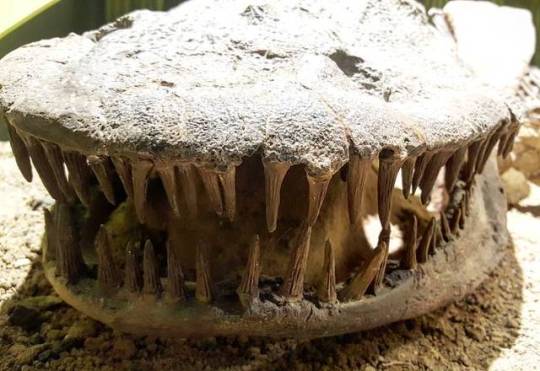
SMILE! It's #FossilFriday! . Eryops' teeth were covered in folded enamel, making them super strong for chomping & holding on to slippery prey. This tooth type is called labyrinthodont meaning 'maze-toothed'. . Come see this specimen in the Permian section of Kirtland Hall next to Dimetrodon at the Cleveland Museum of Natural History @gocmnh! . #cle #cleveland #fossil #thisiscle #permian #eryops #cmnh #museum #fridayfeeling #friyay #ilovemuseums #museumcollections #vertebrate #thatgrilltho #omg #teeth #bones #paleontology #dentist #toothcleaning (at Cleveland Museum of Natural History)
#friyay#cle#permian#museum#dentist#vertebrate#thisiscle#paleontology#eryops#ilovemuseums#fridayfeeling#toothcleaning#teeth#cmnh#museumcollections#bones#omg#fossil#thatgrilltho#cleveland#fossilfriday
168 notes
·
View notes
Text
Trematosaurus

By Scott Reid
Etymology: Hole Reptile
First Described By: Burmeister, 1849
Classification: Biota, Archaea, Proteoarchaeota, Asgardarchaeota, Eukaryota, Neokaryota, Scotokaryota Opimoda, Podiata, Amorphea, Obazoa, Opisthokonta, Holozoa, Filozoa, Choanozoa, Animalia, Eumetazoa, Parahoxozoa, Bilateria, Nephrozoa, Deuterostomia, Chordata, Olfactores, Vertebrata, Craniata, Gnathostomata, Eugnathostomata, Osteichthyes, Sarcopterygii, Rhipidistia, Tetrapodomorpha, Eotetrapodiformes, Elpistostegalia, Stegocephalia, Tetrapoda, Temnospondyli, Eutemnospondyli, Rhachitomi, Erypoiformes, Stereospondylomorpha, Stereospondyli, Trematosauria, Trematosauroidea, Trematosauridae, Trematosaurinae
Referred Species: T. brauni, T. galae, T. thuringiensis?
Status: Extinct
Time and Place: Between 251 and 247 million years ago, in the Olenekian of the Early Triassic

Trematosaurus is found in the Buntsandstein Member of the Solling Formation of Sachsen-Anhalt, Germany; as well as the Lipovskaya Formation in Volgograd, the Yarenskian Formation in Komi, the Gostevskaya Formation in Orenburg, and the Petropavlovskaya Formation in Orenburg, all in Russia.

Physical Description: Trematosaurus was a large, long-headed amphibian that, in general, greatly resembled living crocodilians - but, again, it was an amphibian, and an ocean going one at that. Because the Triassic is always - always - extra. The skull was triangular and fairly long, greatly resembling that of the modern gavial. It had a long, wedge-shaped tail, very short and stubby limbs, and a long and streamlined body. Its feet were probably used as flippers, aiding it in swimming, and the wedge tail would have been extremely useful in propelling the animal forward. As an amphibian, it would have been covered in slippery, slimy skin, rather than scales - which was fine, since it spent all of its time in the water. It had small, sharp teeth, in a skull that was even somewhat hooked - increasing its general crocodile-like appearance. It also had its eyes, very clearly, on the top of its head; its nostrils were at the front of its snout, once again at the top, so it could surface and breathe easily. The skulls of these animals ranged between twenty and forty centimeters long; though the body size is unknown, we could guess somewhere between 2 and 3 meters in length.
Diet: Trematosaurus was decidedly carnivorous, feeding on a variety of fish and other animals in its aquatic habitat.
Behavior: This amphibian would have been extremely mobile and active, swimming around in its environment, hunting food, and searching for new places for feeding. The tail would have been useful in helping Trematosaurus to propel itself forward, while the limbs may have been helpful in steering. It probably wouldn’t have gone to land very much - honestly, those legs were small enough to be useless, so if it went on land it was to rest and maybe to mate. It would have laid its eggs in the water, probably close to the shore in secluded and hidden habitats like in flotsam and other murkey areas, as there were many animals that would have enjoyed some tasty squishy amphibian eggs. Whether or not it was social is difficult to tell; it was certainly common, in fact, one of the most common animals of its area, and it may have hunted or traveled in small groups, much like how frogs are usually found in congregations today - as are crocodilians - though they probably would have been loosely formed ones.
Ecosystem: Trematosaurus lived, in general, in the ocean and near sandy beaches, though it would also venture into aquatic habitats that were more of a mixture of salt and freshwater (ie, brackish water) in river channels and sandy deltas along the sea. This makes sense, as such habitats would have been safer locations for it to lay its eggs. That said, it lived alongside a very wide variety of animals in its norther ocean habitat right after life finally began to recover from the extinction. It lived with the Mastodonsaurid Amphibian Parotosuchus and the giant Lycophyte tree Pleuromeia in the sandy shorelines of Germany. In the oceans of Russia, however, Trematosaurus was surrounded with other animals - sharks such as Hybodus and Lissodus; other fish such as Saurichthys, Watsonulus, Ptychoceratodus, Holophagus, and the lungfish Ceratodus and Arganodus; Parotosuchus again as well as other amphibians like Batrachosuchoides and Dromotectum (a survivor from the Permian); the mystery Synapsid Putillosaurus; and a fun variety of early reptiles. There were tons of Allokotosaurs such as Doniceps, Vitalia, Kapes, Coelodontognathus; the also very crocodile-like but not a crocodile Chasmatosuchus; a Parareptile, Orenburgia; the potential tuataras Scarschangia (which would be one of the oldest tuataras known); a Sauropterygian Tanaisosaurus; the Tanystropheid Augustaburiania; and even ridiculously early Suchians such as Vytshegdosuchus, the Poposaur Bystrowisuchus, and the Rauisuchian Scythosuchus. There were mystery reptiles too, such as the Archosauriform Tsylmosuchus, making the northern oceans of Pangea a fascinating location for the study of the early radiation of Triassic life. Also, indicating that Trematosaurus sure did have a lot to eat - and a lot of competition!
Other: Trematosaurus is one of the Trematosaurids, a group of amphibians that evolved right after the end-Permian extinction for a high level of adaptation for aquatic life. They honestly look very similar to modern gavials, but were completely marine - living in oceans and seas across the Triassic. Trematosaurus itself actually had a shortner snout than some of its cousins like Wantzosaurus and Cosgriffus, though it still was a very crocodilian-like lad despite being an Amphibian. One could really call the Triassic the Age of Crocodiles - if you weren’t a relative of modern ones (ie, a Pseudosuchian), you were either weird - or trying to be one. And Trematosaurus definitely was trying to be an ocean crocodile.
~ By Meig Dickson
Sources Under the Cut
Burmeister, H. 1859. Die Labyrinthodonten aus dem bunten Sandstein bei Bernburg. I. Abtheilung Trematosaurus. Berlin (Reimer).
Damani, R. 2004. Cranial anatomy and relationships of Microposaurus casei, a temnospondyl from the MiddleTriassic of South Africa. Journal of Vertebrate Paleontology 24 (3): 533 - 541.
Ivakhnenko, M. F. 1973. New Cisuralian cotylosaurs. Paleontological Journal 7(2):247-249.
Maisch, M. W., A. T. Matzke, G. Sun. 2004. A relict trematosauroid (Amphibia: Temnospondyli) from the Middle Jurassic of the Junggar Basin (NW China). Naturwissenschaften 91 (12): 589 - 593.
Noviov, I. V. 2010. New data on trematosauroid labyrinthodonts of Eastern Europe: 2. Trematosaurus galae sp. nov.: Cranial morphology. Paleontological Journal 44 (4): 457 - 467.
Schoch, R., and A. R. Milner. 2000. Stereospondyli. Handbuch der Paläoherpetologie - Encyclopedia of Paleoherpetology 3B:1-203.
Schoch, R. R., A. R. Milner, H. Hellrung. 2002. The last trematosaurid amphibian Hyperokynodon keuperinus revisited. Stuttgarter Beitrage zur Naturkunde B: 321.
Schoch, R. R. 2011. A trematosauroid temnospondyl from the Middle Triassic of Jordan. The Fossil Record 14 (2): 119 - 127.
Schoch, R. R. ( 2013): The major clades of temnospondyls: an inclusive phylogenetic analysis. – Journal of Systematic Palaeontology, 11: 673–705.
Schoch, R. R. 2018. The temnospondyl Parotosuchus nasutus (v. Meyer, 1858) from the Early Triassic Middle Buntsandstein of Germany. Palaeodiversity 11:107-126.
Schoch, R. R. 2019. Osteology of the temnospondyl Trematosaurus brauni Burmeister, 1849 from the Middle Buntsandstein of Bernburg, Germany. Palaeodiversity 12: 41 - 63.
Spencer, P. S., and G. W. Storrs. 2002. A re-evaluation of small tetrapods from the Middle Triassic Otter Sandstone Formation of Devon, England. Palaeontology 45(3):447-467.
Steyer, S. J. 2002. The First Articulated Trematosaur 'amphibian' from the Lower Triassic of Madagascar: Implications for the Phylogeny of the Group. Palaeontology 14 (4): 771 - 793.
Tverdokhlebov, V. P., G. I. Tverdokhlebova, M. V. Surkov and M. J. Benton. 2003. Tetrapod localities from the Triassic of the SE of European Russia. Earth-Science Reviews 60(1-2):1-66.
Watson, D. M. S. 1919. The structure, evolution and origin of the Amphibia.—The "orders" Rachitomi and Stereospondyli. Philosophical Transactions of the Royal Society of London, Series B 209:1-73.
Werneburg, R. 1993. Trematosaurus (Amphibia) aus dem Mittleren Buntsandstein (Untertrias) von Thüringen. Veröffentlichungen des Naturhistorischen Museums Schleusingen 7/8:17-29.
#trematosaurus#trematosaurid#temnospondyl#triassic#triassic madness#triassic march madness#prehistoric life#paleontology
124 notes
·
View notes